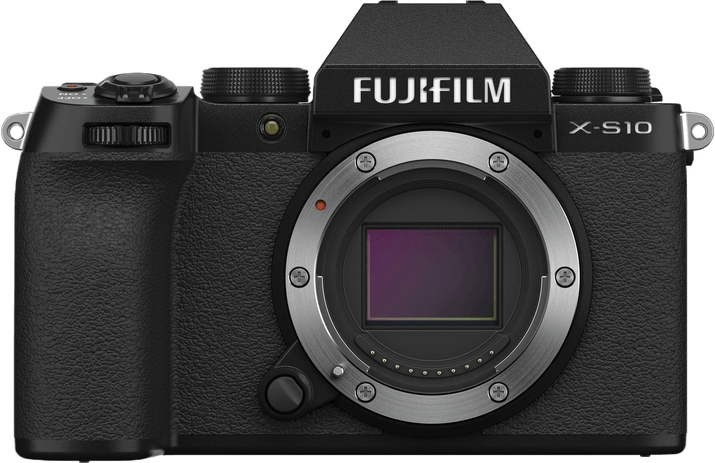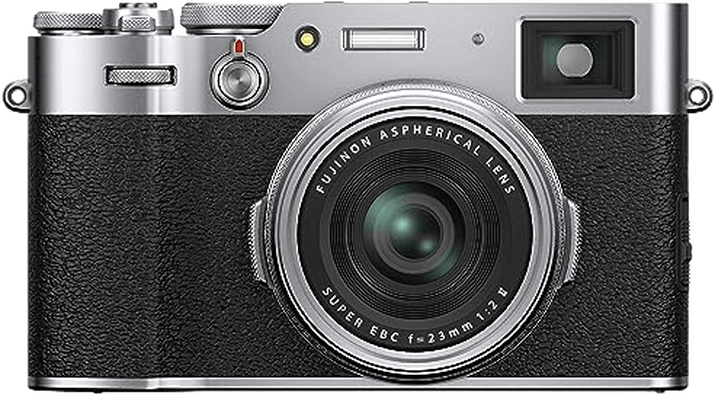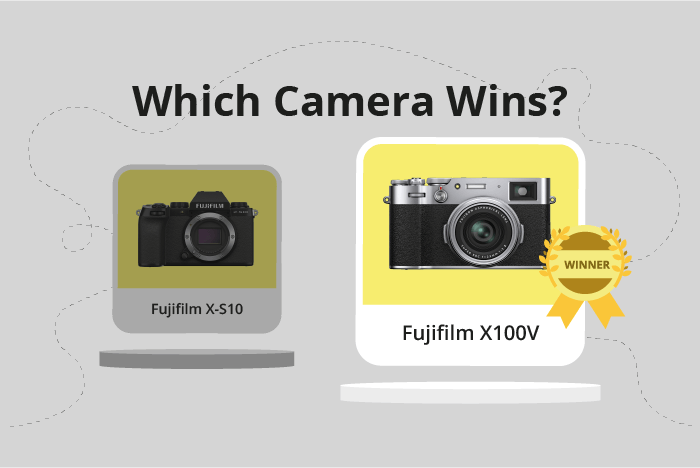Fujifilm X-S10 vs X100V Comparison
Fujifilm X-S10

Fujifilm X100V

The Fujifilm X-S10 and X100V both score 69/100, making them equally matched in terms of their overall capabilities. As mirrorless cameras released in 2020, they share several key specifications. Both cameras have a launch price, with the X-S10 at $999 and the X100V at $1399.
The X-S10 stands out with its slightly lighter weight of 465g (1.03lbs) and dimensions of 126 x 85 x 65mm, making it more compact and portable than the X100V, which weighs 478g (1.05lbs) and measures 128 x 75 x 53mm.
On the other hand, the X100V has a higher launch price, indicating a potentially higher quality build or additional features. However, this difference may not be significant enough for some users to justify the additional cost.
Considering their similar scores and shared specifications, both cameras offer excellent performance for their respective price points. The choice between the two ultimately depends on individual preferences for size, weight, and budget.
Fujifilm X-S10 vs X100V Overview and Optics
The Fujifilm X-S10 takes the lead in optics with a score of 72/100, compared to the Fujifilm X100V’s score of 66/100. Both cameras share several common specifications, including 26-megapixel resolution, a CMOS sensor type, the X-Processor 4, an APS-C sensor size, and the absence of a DXOMARK score.
The X-S10 outperforms the X100V in two key areas: shooting speed and image stabilization. The X-S10 boasts a shooting speed of 20 frames per second (fps), providing faster performance than the X100V’s 11 fps. This difference allows the X-S10 to capture action shots and fast-moving subjects more effectively. Additionally, the X-S10 has built-in image stabilization, which helps reduce camera shake and blurry images, particularly in low light conditions or when using slower shutter speeds.
On the other hand, the X100V has a fixed lens mount, which may be seen as a disadvantage compared to the interchangeable Fujifilm X lens mount on the X-S10. However, some users may appreciate the simplicity and compactness of the X100V’s built-in lens system, without the need to carry and change multiple lenses.
Taking these factors into account, the Fujifilm X-S10 proves to be the better option in terms of optics, offering greater versatility and performance with its faster shooting speed and image stabilization. While the X100V may appeal to some users who prefer a simpler, more compact camera, its fixed lens and lack of image stabilization limit its capabilities compared to the X-S10. Therefore, the X-S10 stands as the superior choice for those seeking a camera with better optical performance.
Fujifilm X-S10 vs X100V Video Performance
The Fujifilm X-S10 and Fujifilm X100V both have a video score of 91/100, showing that they have comparable video capabilities. Both cameras share common specifications, including a maximum video resolution of 4K and maximum video dimensions of 4096 x 2160. Additionally, both cameras have built-in time-lapse functionality.
The Fujifilm X-S10 outperforms the X100V in terms of maximum video frame rate, offering 240fps compared to the X100V’s 120fps. This higher frame rate allows the X-S10 to capture smoother slow-motion footage, making it a better choice for those who frequently shoot action or sports scenes.
On the other hand, the Fujifilm X100V does not surpass the X-S10 in any specific video-related specification. However, it still matches the X-S10’s overall video performance, making it a solid choice for those who prioritize other aspects of camera performance, such as design or optics.
Both the Fujifilm X-S10 and X100V are strong contenders for video performance with their identical scores and shared specifications. The X-S10’s advantage lies in its higher maximum video frame rate, which is beneficial for slow-motion capture. Meanwhile, the X100V does not outperform the X-S10, but its equal video capabilities make it a viable option for those who value other camera features. Ultimately, the choice between these two cameras will depend on the individual’s needs and preferences.
Fujifilm X-S10 vs X100V Features and Benefits
The Fujifilm X100V emerges as the winner with a feature score of 85/100, while the Fujifilm X-S10 scores 70/100. Both cameras share certain specifications, such as a 3-inch screen size, touchscreen capability, flip screen, and Bluetooth connectivity. However, the X100V excels in certain areas, making it the superior option.
The X100V has a higher screen resolution of 1,620,000 dots, compared to the X-S10’s 1,040,000 dots. This difference results in a sharper and clearer display on the X100V. Additionally, the X100V is equipped with Wi-Fi, which the X-S10 lacks. This feature allows for easier and faster image transfers and remote camera control.
The X-S10, however, does not offer any significant advantages over the X100V in terms of features. Both cameras have the same screen size, touchscreen, flip screen, lack of GPS, and Bluetooth connectivity. The lower feature score of the X-S10 reflects its inability to outperform the X100V in these areas.
Considering the differences and similarities, the Fujifilm X100V is the better option due to its higher screen resolution and Wi-Fi connectivity. While the X-S10 is not a bad choice, it does not provide any additional benefits over the X100V in terms of features. Therefore, the X100V is the recommended camera for those seeking a more feature-rich and convenient photography experience.
Fujifilm X-S10 vs X100V Storage and Battery
The Fujifilm X100V outperforms the Fujifilm X-S10 in storage and battery with a score of 37/100 compared to the X-S10’s 35/100. Both cameras share some similarities in this category, such as having a single memory card slot and accepting SD, SDHC, and SDXC (UHS-I compatible) cards. Additionally, both cameras offer USB charging capabilities.
The X100V’s advantage lies in its longer battery life, providing 420 shots per charge compared to the X-S10’s 325 shots. This difference in battery life is due to the X100V using the NP-W126S battery, while the X-S10 uses the NP-126S battery.
However, the X-S10 does not have any specific advantage in storage and battery over the X100V. The X100V’s superiority in battery life makes it the more reliable option for extended shooting sessions, whereas the X-S10 may require more frequent battery changes or charging. Both cameras provide adequate storage options with their shared memory card compatibility.
Fujifilm X-S10 vs X100V – Our Verdict
Are you still undecided about which camera is right for you? Have a look at these popular comparisons that feature the Fujifilm X-S10 or the Fujifilm X100V:

